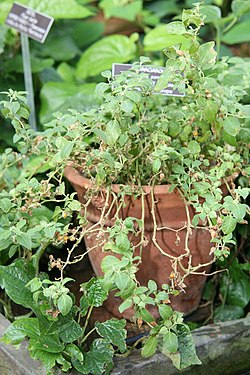Withania somnifera
| Withania somnifera subsp. var. | Ashwagandha | |||||||||||||||||||||||||||||||||||||||||||||||||||||||
|---|---|---|---|---|---|---|---|---|---|---|---|---|---|---|---|---|---|---|---|---|---|---|---|---|---|---|---|---|---|---|---|---|---|---|---|---|---|---|---|---|---|---|---|---|---|---|---|---|---|---|---|---|---|---|---|---|

|
|
| ||||||||||||||||||||||||||||||||||||||||||||||||||||||
| ||||||||||||||||||||||||||||||||||||||||||||||||||||||||
Withania somnifera, also known as Ashwagandha, Indian ginseng, Winter cherry, Ajagandha, Kanaje Hindi, Amukkuram in Malayalam and Samm Al Ferakh, is a plant in Solanaceae or nightshade family.
It grows as a stout shrub that reaches a height of 170 cm ft . Like the tomato which belongs to the same family, it bears yellow flowers and yellow-Orange to red Barry type fruit, though its fruit is berry-like in size and shape. Ashwagandha grows prolifically in India, Nepal, Pakistan, Sri Lanka and Bangladesh. It is commercially cultivated in Madhya Pradesh (a state in India).
An evergreen Shrub growing to 1m by 0.5m.
It is hardy to zone 9 and is frost tender. It is in leaf all year. The flowers are hermaphrodite (have both male and female organs)
Cultivation
A fairly easily grown plant, it requires a warm sheltered position in full sun and a well-drained moderately fertile soil[169, K]. Prefers a dry stony soil[238]. This species is not hardy in temperate climates but it can be grown as an annual, flowering and fruiting in its first year from seed[169].
Propagation
Seed - sow early spring in a greenhouse. There is usually a high germination rate within 2 weeks. Prick out the seedlings into individual pots once they are large enough to handle and plant them out after the last expected frost. Consider giving the plants some protection, such as a cloche, until they are established and growing away well.
Pests and diseases
Varieties
Subspecies: Withania somnifera Dunal and Withania ashwagandha Kaul are the two sub-species of the plant.
Gallery
-
photo 1
-
photo 2
-
photo 3
References
- Plants for a Future - creative commons text incorporated
External links
- w:Withania somnifera. Some of the material on this page may be from Wikipedia, under the Creative Commons license.
- Withania somnifera QR Code (Size 50, 100, 200, 500)

